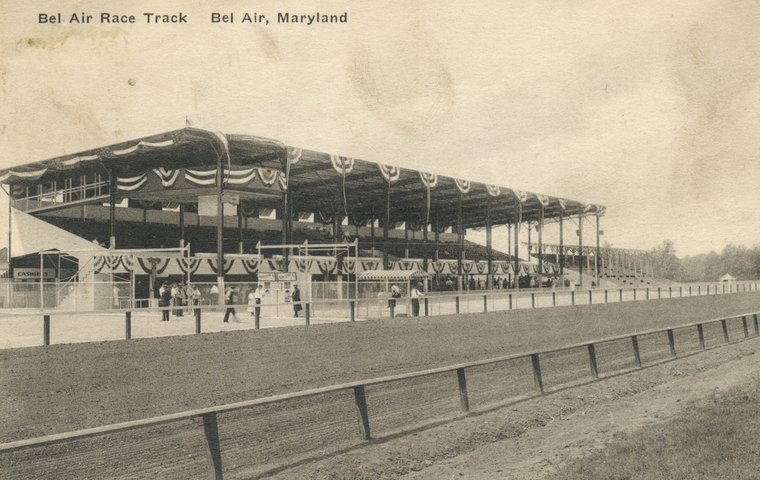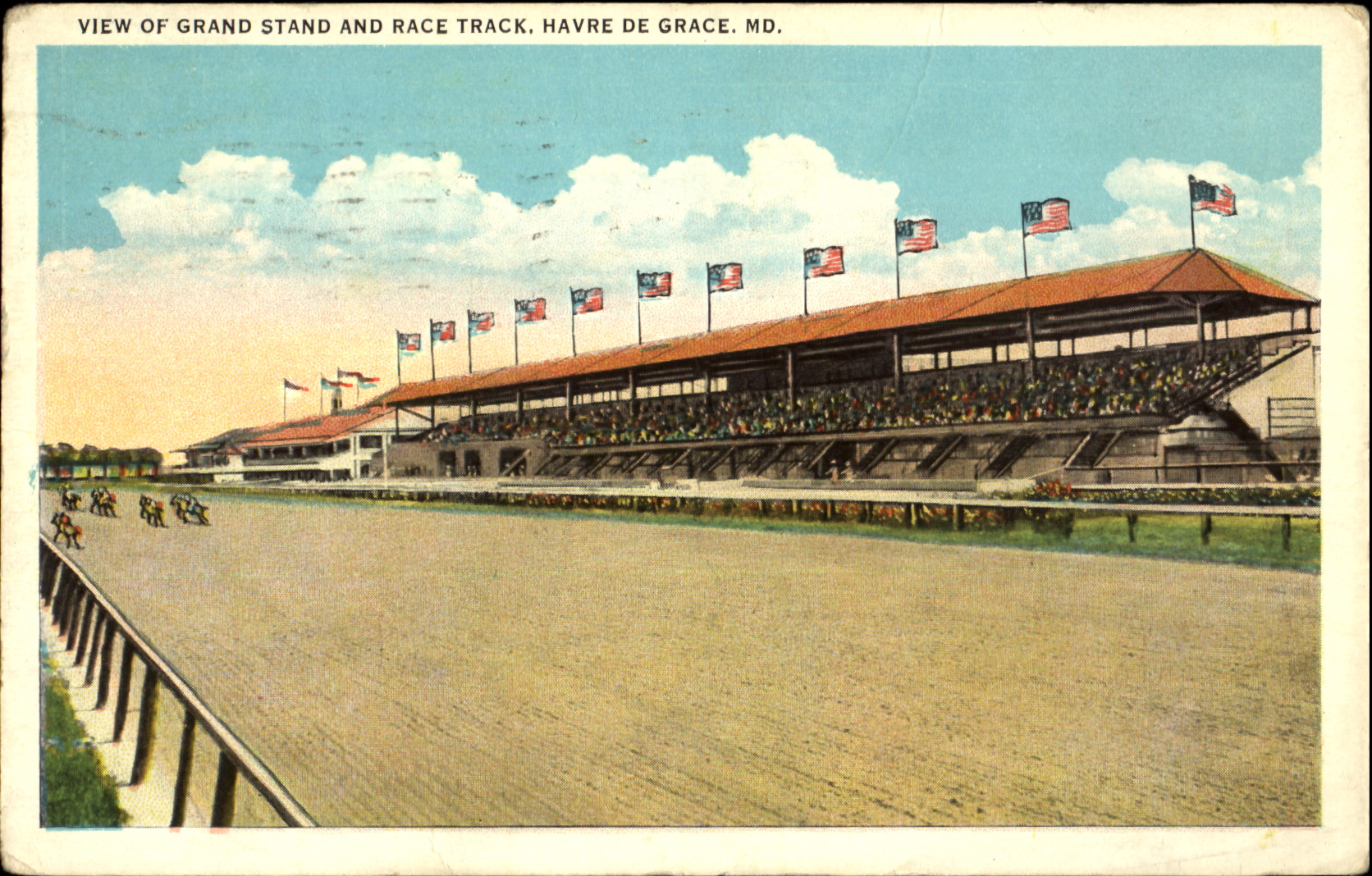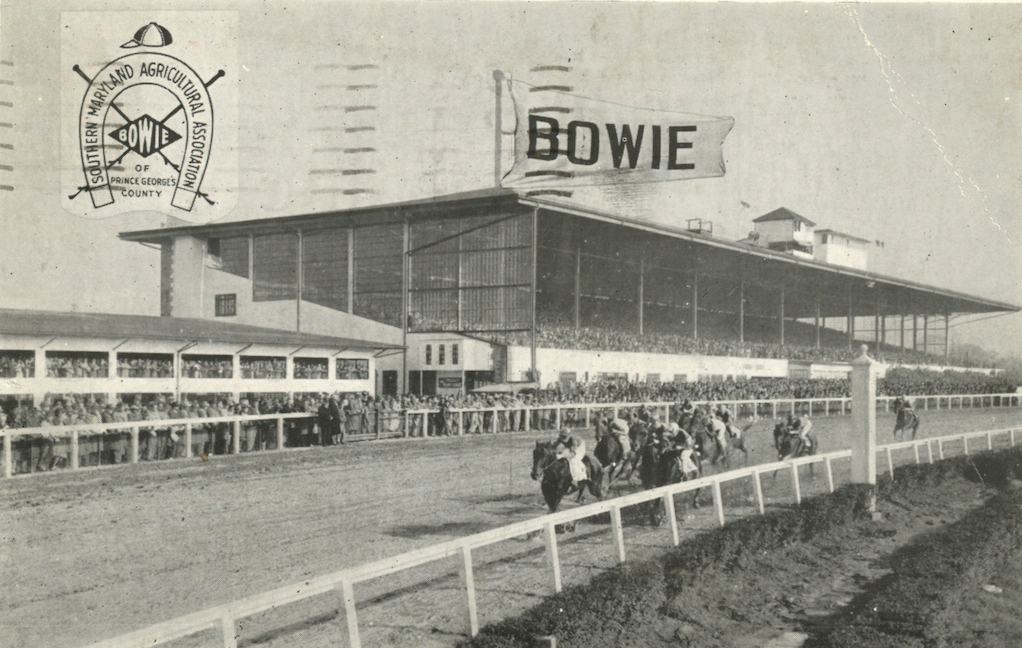
Today, Thoroughbred racing in Maryland is best known by the second jewel in racing’s Triple Crown, the Preakness Stakes. This was not always the case. In years gone by, a full calendar was held at racetracks across the state. But the status of Thoroughbred racing in Maryland has waxed and waned since colonial times, and many of the racecourses to which vast crowds thronged now survive only in memory.
The foundation of a great tradition
According to racing lore, it was in Maryland that Thoroughbred racing was formally introduced to the colonies. True, it was to neighbouring Virginia that the first Thoroughbred was imported in 1730, but it was in Maryland that, in 1743, the first jockey club in the U.S. was founded.
The first races in Maryland were held at informal tracks or fairgrounds. After the foundation of the Maryland Jockey Club, purse racing and racing for cups became a regular amusement.
Every autumn and spring, races were held at Marlborough, Chestertown, Joppa, and Elkridge, as well as at Annapolis and Williamstadt. These races tended to be tests of endurance, held in mile-long heats.
There was a race ground near Annapolis, likely located at Parole. In one of his diaries, one frequent visitor bemoaned losing a pound and two shillings at the Parole track. His name was George Washington.
Bel Air Race Track
Despite the early enthusiasm for racing in Maryland, it was well over a century after the foundation of the Maryland Jockey Club that formal racing venues were established. The first was Pimlico (founded in 1870), followed closely by Bel Air.
Founded in the early 1870s just when Thoroughbred racing was beginning to re-establish itself in Maryland after the Civil War, Bel Air’s early history is typical of the smaller tracks that opened across the state in this period.
Laid out on a 100-acre plot, the racecourse featured a half-mile track and hosted a wide variety of events, ranging from Thoroughbred racing to unregulated races, harness racing and athletics events. In 1874, attendees could even witness jousting at the track.
Racing at Bel Air spluttered to a halt in the early 20th century, when the track was closed. However, elsewhere in the state, racing was thriving and many new racetracks were founded during this period.
In addition to Pimlico and the foundation of the ‘milers’ – Laurel Park (founded 1911), Havre de Grace (1912) and Bowie (1914) – racing grew increasingly popular at half-mile tracks. This popularity led to the opening of several new ‘half-milers’ and, moreover, the resurrection of Bel Air in 1937.
For several years, the track flourished under the leadership of its new owner, George Ray Bryson, a noted breeder and horseman. A new grandstand was built for the 1937 meeting, and the track was improved and lengthened to three quarters of a mile.
Crowds flocked to Bel Air, with attendance ranging between 6,500 and 15,000. The race card was varied, usually encompassing two standard races followed by the steeplechase, and then an assortment of harness, motorcar and other races.
Crowds flocked to Bel Air, with attendance ranging between 6,500 and 15,000. Consistently, it broke records both for attendance and wagering on Maryland’s minor circuit. By 1949, the racetrack had outgrown its so-called ‘small tote’ and so installed a big-track totalisator to provide more betting windows and the faster sale of tickets. A new odds, payoff and jockey change board was also erected in the centerfield, parallel to the grandstand and clubhouse, which were themselves enlarged considerably.
Behind the scenes, though, all was not well at Bel Air.
The track was known for match fixing and the substitution of horses, and it became the focus of a public, political dispute between the state governor and the former chairman of the Racing Commission.
This bad blood coincided with the general waning of the shorter tracks across Maryland. One by one, the half-milers closed as the more prestigious miler tracks purchased the rights to their races. At the same time, new harness racing venues such as the Baltimore Raceway (1950) were opening across the state, tempting racegoers away from the half-mile tracks with larger capacities and grander facilities.
The death knell for Bel Air Racetrack rang with Bryson’s own. Following his death in 1957, Jerry Hoffberger, a local breeder, persuaded the state legislature to transfer Bel Air’s race dates to Pimlico, Laurel and Bowie. It closed in 1960 and its dirt track is now hidden under layers of cement and asphalt beneath the Harford Mall.

Havre de Grace Race Track
In the early 20th century, racing in the United States was at an all-time low. Anti-gambling sentiment saw the forced closure of racecourses in state after state. All except two – Kentucky and Maryland.
While the Thoroughbred industry dwindled in neighbouring states, Maryland was a natural beneficiary. Several new tracks were constructed, including Havre de Grace.
Havre de Grace opened its doors on August 24, 1912. The grandstand, clubhouse and paddock were built in less than two months, as a cost of $125,000, plus $20,000 for the land. New York racing legend August Belmont provided much of the capital. Affectionately dubbed ‘The Graw’ by locals, the track attracted first-rate horses, moneyed owners and the very best trainers and jockeys.
The grandstand offered a single tier of seating beneath a wooden pitched roof topped by a proud series of flagpoles.
The adjacent clubhouse was architecturally more ambitious. Built in the neo-classical New England style, the white-painted wooden building offered views of the track from its shaded first-floor seating. At its eastern end, a stylised arcade supported a first-floor balcony, topped by a large white pediment. An octagonal lantern capped the building, replete with another flagpole. Finally, a pagoda-style Judge’s Tower was situated trackside, completing the facilities at the racecourse.
The Graw attracted many of the best horses ever to race on American soil. In 1920, Man o’ War won the Potomac Handicap at Havre de Grace, and in 1936, his son War Admiral won his very first race there. The Havre de Grace Handicap was one of the important races in the American northeast for many years, whose winners included U.S. Racing Hall of Fame inductees Roamer, Crusader, Seabiscuit, Sun Beau, Equipoise and Challedon.
Nonetheless, following World War II, Havre de Grace could not withstand the competition of nearby Garden State Park and Delaware Park in New Jersey. In 1951, the track was sold to Alfred G Vanderbilt II, owner of Pimlico Race Course, and Morris Schapiro of Laurel Park, who promptly transferred its racing dates to their own tracks and closed its doors permanently.
The racetrack was sold to the National Guard, which occupies the site to this day.

Bowie Race Track (Prince George’s Park)
“There breathes no hardier band than the Bowie breed of better.” So wrote Shirley Povich in the Washington Post on February 16, 1958, coining a fitting phrase to define the loyal fans of winter racing at Prince George’s Park, better known as Bowie Racecourse.
Throughout its 61-year history, Bowie was ‘the race track on the other side of the track’, attracting controversy, innovation and intrigue.
Bowie introduced winter racing in Maryland when none had thought it possible; it muddled on through fires, snowstorms and scandals; and it attracted an avid cohort of loyal fans uninterested in the trappings and ornament often associated with the Sport of Kings. Despite this unorthodoxy, Bowie hosted several of the state’s biggest races, including the first $100,000 stakes in Maryland.
Bowie opened its doors on October 1, 1914, as one among a clutch of racing venues catering to the vibrant Thoroughbred racing circuit in the state. Situated on a sandy patch of land deep among the pines of Prince George’s County, the one-mile dirt track was located roughly equidistant between Washington and Baltimore on the railway line that connected the two. Its central position and relative accessibility helped it to attract fans from across the Mid-Atlantic region.
For its first few months of operation, Bowie lacked an official license for racing and so was known as an ‘outlaw track’, a premonitory (if unintended) manifesto for the years to come. The track soon gained a licence from the Maryland Jockey Club, however, and began to host sanctioned meetings in 1915.
Bowie swiftly became known for doing things differently. In March 1930, it began opening for a spring season, attracting 20,000 fans eager to resume racing after winter.
Two decades later, as the popularity of racing surged following the close of the Second World War, Bowie began to garner a reputation as a pioneer for winter racing in the U.S. In 1952, the track underwent a comprehensive $2m renovation, to improve facilities and increase capacity on site. However, the grandstand remained open to the elements, which often subjected winter racegoers to below-freezing temperatures and gusting winds. The grandstand also faced west, a problem when the glare of the low-lying winter sun dazzled fans and interrupted views of the racing.
Opening dates for winter racing got earlier as the decade progressed. In 1958, Bowie opened on February 8, the earliest racing ever to take place in Maryland. Despite freezing temperatures, nearly 18,000 fans showed up for the opening day.
The carnival atmosphere reached new heights a week later when, on February 15, a blizzard stranded several thousand at the track. Not to be discouraged, they spent the night holed up in the clubhouse eating sandwiches and playing cards and dice. Several days later, renowned sports writer Shirley Povich forever baptized the track’s loyal fans as the ‘Bowie Breed’.
Time and again, Bowie jockeys, staff and horsemen proved their hardiness and resilience. Bad weather rarely cancelled the race card, with track officials adopting the mantra: “When it snows, Bowie goes.”
Racing conditions were often harsh, requiring horses to plough through muck and mire, against driving rain, sleet, snow and fog. Once, in 1975, when his mount stumbled in the quagmire, jockey Danny Wright fell in mud so deep that he was buried alive before being pulled from the ooze.
Bowie racecourse was peculiar in its misfortune. The track was plagued by fires, which 11 times ravaged the track, killing 104 horses and destroying dozens of stables. But two events stand out for their strangeness: a severe railway accident in 1961, and the so-called Valentine’s Day Massacre of 1976.
On February 2, 1961, one of the trains carrying racegoers to Bowie Racecourse jumped the tracks just short of the station in an accident that killed six passengers and injured over 200. Yet a number of the walking wounded, driven by their desire to place their bets before the last race of the day, clambered over the injured and hurried on foot to the racecourse. According to the Baltimore Sun, one man hobbled to the track with a broken collarbone, such was his desire to witness the racing.
With uncomfortable irony, just one month earlier the legendary sports writer Red Smith had reported that “Horse players love to suffer. They are never truly happy unless they are miserable – freezing or sweltering or drenched by rain, [and] nowhere has this design for living been honoured more faithfully than at Bowie.”
On Valentine’s Day, 1976, Bowie Racetrack was hit by the most infamous betting scandal ever to rock Maryland Racing.
In the last race that day, several jockeys conspired to fix the race, and to cash in on a triple-box wager – a bet that, not-so-coincidentally, had been purchased 38 times by one bettor, who also happened to be the brother of one of the jockeys competing in the race. Had the scam not been discovered, the total payout would have surpassed $35,000. The case, investigated by the FBI, took several twists and turns, but resulted in four of the jockeys being sentenced to six months in federal prison with their riding privileges revoked indefinitely. Tragically, the jockey Eric Walsh, who had professed his innocence throughout the trial, took his own life rather than go to jail.
Despite the controversies and calamities that dogged the racecourse throughout its lifetime, the majority of its record testified to good racing. However, both attendance and betting at Bowie began to fall from around 1970. Casinos in Atlantic City siphoned off out-of-town gamblers, and other tracks started to introduce winter racing. Unable to compete with such tenacious competition, on July 14, 1985, Bowie ran its last race.
The track gained a new lease of life as a training centre, although in April 2015 this facility closed as part of the consolidation of Thoroughbred facilities across the state.
The future of the track is uncertain. Although the cessation of operations at Bowie represents the end of an era for the ‘racetrack on the other side of the tracks’, what is certain is that the Thoroughbred tradition in Maryland lives on.
Sources
Carol Deibel, The Bel Air Chronicles (The History Press, 2002)
Bill Bates, Bel Air (Arcadia Publishing, 2004)
Brooke Gunning and Paige Horrine, Maryland Thoroughbred Racing (Arcadia Publishing, 2005)
‘The Original Havre de Grace’, Blood-Horse Magazine, 14 January 2012
R Hale, ‘History challenge: Memories of Havre de Grace Racetrack live on’, Daily Racing Form, 20 September 2012.
‘Havre de Grace Racetrack opens, 1912’, Colin’s Ghost, Thoroughbred Racing History, 29 September 2009
M Klingaman, ‘A track unlike any other, Bowie could soon be closed’, The Baltimore Sun, 27 November, 2010
Ted Black, ‘Bowie Race Track turns 100’, Capital Gazette, 7 October 2014
F Rasmussen, ‘Right (and wrong) on track’, The Baltimore Sun, November 1, 2003
‘Six Horses Lost in Fire at the Bowie Racetrack’, Chicago Tribune, November 22, 1916
Kevin Martin, ‘Winter Racing and the “Bowie Breed”, 1958’, Colin’s Ghost: Thoroughbred Racing History, January 31, 2009


